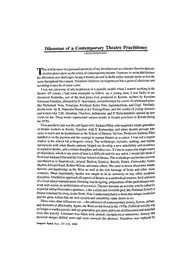
Dilemmas of a contemporary theatre practitioner PDF
Preview Dilemmas of a contemporary theatre practitioner
Dilemmas of a Contemporary Theatre Practitioner CHANDRADASAN T hiswillbemoreofapersonalchronicleofmydevelopmentasatheatredirectorthanany • eruditeobservationonthestatusofcontemporary.theatre.Iventuretowntethisbecause thedilemmasandchallengesfacingatheatrepersoninIndiatodayremainmoreorlessthe samethroughoutthecountry.ThereforeIbelievemyexperiencehasageneralcharacter.and recordingitmaybeofsomevalue. IwasnotconsciousofanyinspirationoraspecificmodelwhenIstartedworkinginthe theatre.Ofcourse, I had some examples 10 follow. As a young man, I was lucky 10 see A"unumn Kadamba, oneofthe best playsever produced in Kerala, written by Kavalam NarayanaPanikkar,directedbyG.Aravindan,andperformed byahostofcelebratedactors like Nedumudi Venu,Natarajan, KrishnanKutty Nair,Jagannnathan, and Gopi.Similarly, productions byR.NarendraPrasadat theNatyagriharn, and the works ofyoungdirectors and writerslikeT.M.Abraham,Omcheri,Indukurnar and P.Balachandranopenedupnew vistasforme.Theseworksrepresented varioustrendsintheatrepracticesinKeraladuring the19705. OverandabovethiswasthecultfigureofG.SankaraPillai,whoinspiredawholegeneration oftheatre workers in Kerala. Together with S.Ramanujan and other theatre personswho cametoteachanddoproductionsattheSchoolofDrama,Trichur,ProfessorSankaraPilJai instilledinusthepassionandthecouragetopursuetheatre asacareer. Iwasnotaregular studentatthe school but afrequentvisitor.The workshops,lectures, writing, and regular interactionswithothertheatrepersonshelpedmedevelopanewsensibilityandaesthetics inregardtotheatre.andacertaindisciplineandethicstoo.lfIamtonameonesinglesource ofinspiration.whichatanypointcf'timeisadifficulttaskforanyartist,Iwouldstillthinkof ProfessorSankaraPillaiandtheTrichurSchoolofDrama.Theworkshopsandlecturesessions introduced ustoStanislavski,Artaud,Beckett,Ionesco,Brecht, Pinter,Grotowsky,Genet, Shaffer,EdwardBond,RobertWilson,andmanyothers.Wecarnetoknowaboutnewtrends. theoriesand happenings inthe West,as wellas the rich heritage of India and otherAsian countries.Moreimportantly,theatre wastaughttous asseriously asanyotheracademic discipline.Ithelpedusapproachallaspectsoftheatreinamethodical manner,beitselection ofascriptanditsinterpretation,blockinganddesigning,preparationoftheperformancetext, workwithactors,ormobilizationofresources.Theatrebecameanactivitywhichcalledfor expertiseandprofessionalexperience.Likeasilentandinvisiblegod, theNationalSchoolof Dramaremainedfaraway,intheNorth.NowIunderstandthatitisfromthisuniqueinstitution andthegreatAlkazithatthenewsystemand sensibilitycamedownto us. There~ereothe~influencestoo- theinfluenceofcontemporarypoetry.fiction.culture. anddoctrinesofphilosophy.Again,theWestsetthetrendinthe19705.Politicalactivitywas nolong~rawo~ypursuit,andmygenerationgotmoreandmoredisillusionedanddetached from thisactivlty,~iterature was filled with surreal, metaphysical narratives; fantasyand personal,mages drifted more and more towards theabstract. Narrative wasreplaced by SGngeel NlJtal: Nos. 137-138. 2000 DILEMMAS OF A THEATREPRACTmOSER 17 expressionisticandothernewtechniques.Evenlanguagewashandledinsuchamannerthat anoriginalworkinMalayalamoftenlooked,read,andsoundedlikeatranslationfromanalien language. This no doubt elevated the artistic expressionand helpedthewriterdealwith complexlayersoflife,butthenativellavourwaslost.Withabroaderspectrumofauthorship, anew sensibilityandequipment,ourliteraturebecame 'international'.Itwasonlynatura) thatthese newtrends inliteratureshouldaffectthetheatreanditsaesthetics. Exposure tocontemporaryWestern literaturetogetherwith formalschoolingintheatre led10modernisticexperimentsintheKeralatheatre.ManyplaysofBrecht.Bedell.Pinter and Genet were performed on rural stages to astounded villagers. In 1986. Iproduced Deathwatch:for a villagetheatre group; wefellthatthetheatreinKeralahadnowbecome experimentalandmodem.Buttheexcitementdidnotlast.Thevillagersrefusedtoappreciate theseabstruse experimentsintheatre.Theycouldnotrelatetheirexperiencesandday-to daylifewith the situations portrayed intheavant-gardetheatre.It failedtoexpresstheir culture.history.andaestheticsensibilities. Theattemptto buildupanindigenoustheatre wasgoingonsimultaneouslywith these experimentations.KavalamNarayanaPanikkarwasgoingaheadwithhisownsearch.and G.SankaraPillaitoldusthat"thetheatreoftheearthisneverdead"- wehavetoexploreour ownroots. Butmanyoftheseinquirieslackedtheemotionalenergycharacteristicofatrue: theatricalexperience,anddidnotrelatetocontemporaryexperience.The prosceniumwas abandoned andthetheatre moved to non-conventional spaces.Folkperformanceswere revived tofashionnewtoolsofexpression.Manyyoungsters,includingmyself,joinedthis quest.Variousart forms _ archaicorrecent, crudeorfine. rituals.dance-dramas-were: revisitedwithanewpurposeandenergy. . Throughthisprocess, Iclearlyunderstoodthatmytheatrehad10bemouldedonmylife andenvironmentifIreallywantedtocommunicatewithmypeople.Thestyle.theform,and the technique had to evolve from my encounterswiththepastand thepresent,WIth my specificculture.Thatis,mytheatrehadtoberootedinthesmallvillagein.KeralawhereIwas bornandbrought up.Thecolourfulfestivalprocessiongoingupthe.windingvdlage.path, o~black upthelittlemound.hadtogivememymovementpatterns:thefiercentes magic.and theexorcistritualswitnessedinchildhoodhad10bethesourceofmyemotionalecstasy.the musichadtocomefromthesongsofthepaddy-fieldandthesongsofthewaveringdrunkard: theecstasyof thedevotee'dancing withanarrowpiercinghischeeks.likeonepossessed. . . f ~ Thenarrative hadtogivemetheenergytowithstandthepressureandstrain0 pellonnances.. . styleandtechnique hadtocomefromthestoriesthevillagetoldme;thescemcdesignhad tocome from the paddy-field, playground, secret meetingplaces inthebushes,.andthe ChJldh~ awesomegraveyardsurroundedbyhighwalls.Theheroes.gods,anddemonsof theancestors.andsimplelivingmortalshadtobethecharacters;theidolsandIconscarne inchurchprocessions and bythepariahsduringtheirfestivals.hadtobethesourceofmy . ' li . dthes bdetyWIthwhich Images.Therealityofvillagelifehad10givemethestory-me.an u d h theV.illagercommunicatesh0isagonies.anxj.et'res,andreealionstotheworldha 10etdeiae mde theessence of the art of theatre.The villagewith allitscolour.emotions.trag resan celebrationsdidinfactinspiremytheatre. th . II ce of the West its . tfreefrom em uen . But even this search forourrootswasno CHAI<DRADASAN 18 perceptionsandaestheticunderstanding.RustomBhamchacriticiz.esthisindigenoustheatre. referringtotheworkofRatanThiyarninthesewords: Thiyam'stheatre.Iwouldsay.hasbeenstronglyinfluencedbyhisexposuretoproscenium theatre,asrepresentedtohimbyhismentorAlkaziattheNationalSchoolofDrama.His framingofaction. timingsofexitsandentrances,lateralgroupings.useofcyclorama. aboveall,histacitrefusaltoconfronttheaudienceswithabreak.inthenarrativeordirect addresses-c-theseareconventionsthatstronglyupholdtheillusionofthe fourth wall. Iquotethis because,as ageneralobservation, I feel itcan apply to anycontemporary theatrepractitionerinIndia.Thefourthwallisnotthebasicproblem.Itistheaestheticsand conventionsfollowedtoachieve 'professional' standards in theatre whichconstitutethe real block. These standards are set somewhere in the West - in the Royal Academyof DramaticArts(RADA),intheprofessionalhousesonBroadway,orelsewhereinAmericaor Europe. Professionalexcellenceismeasuredintermsofperfectionofthecraftoftheactor and perfection of stage technicalities;designed to create a smooth and pleasing product. Thepracticesandprioritiesofourowntheatrehavebeenresettoachieveaperfect'process' and'product',asdictatedbyWesternsensibilities.Thustheatrehas becomemoreandmore an elite and urban activity,moving away from the soul ofthe rural Indianheartland.The political and cultural features of India's histrionic tradition, and Indian sensibilities,have beenignoredinthismadraceforprofessionalism.Evenournativeethoshasbeenreinvented to meet thedemands of the West.Manyof our myths andfolk tales have been retoldand refabricated to suit Western perceptions of sensuality and sexuality. Producing glossy literaturetoselltheshowhasbecometheliabilityoftheartist.Theprimaryfeaturesoflndian theatre- spontaneity,aninformalambience,theinvitationtothespectatortojoininand complete the creation, and the sense that the meaning of theatre extends beyond the production- havebeenlost.Buttheatreafterallisnot'presentation','representation',or amereexhibitionofcraft- a 'show' - as understood by the West today. Unfortunately,ourtheatreeducationwasmodelled onRADA,andimpartedbyRADA· educated gurus. Indian narrative and performance practices which could transcend the barriersofclassandcaste wereforgotten.Ourtheorizationistodaylimitedtourbanreality, o~ten focused onMandi House.Our schoolsofdrama,including NSD, refuse toacceplor :urnatanaUd~enceoutsidethecitylimits.Infact,wearealwaysaddressingthenon-audience 10 a few Indian cities. We are catering to the fake sensibilities of urban academics and intellectuals, creating any, spectacular, expensive productions full of abstract imagery, symbols,and slippery 'sub-texts'. WesternagencieswhichfinancetheatreactivitiesinIndiaencourageustoresearchinto the 'universality,oftemporalexperience'byalienatingnativepracticesfromtheirrootsand context.Productions with a fake physicality.involving alot of wasted human activity evenexercises~.rderingongymnastics_ areencouraged.:\1anyoftheseproductionsare onlyofacademicmterest.AtleastinKerala,manytheatrepersonswhohavebeenfundedby these ag:nc,es have stopped doing theatre altogether!They seem 10 have lost all reason. anddontevenseemtounderstandtheirownwordsoractions.Andthetragedyisthatthey DILEMMAS OFA THEATREPRACTITlO~ER wereradicalsintheir 'pre-funded' days,anddidpowerfulandmeaningfultheatre. Weshouldbeawarethattheresourcesofourtheatreareadequatetoaddressthedemands ofourtime,todeal withcontemporary issues,andtocommunicatedirectlyandeffectively withtheaudience.WeshouldnotforgetthatoneofthemastersofIndiantheatre,ShriHabib Tanvir,parted ways with his RADA trainingto workwiththetribalsofChattisgarh and develophisowntheatre.WeshouldalsorecallthestatementofBadalSircar- fortheatreto bemeaningful,ithastobeamateurand notprofessional. Ifeel thataconsciousattempthasto bemadetorevitalizeandreinvent an alternative Iodiantheatrefreefromtheformalistic,urbanized,eliteaestheticismwhichisthehallmarkof 'good'theatretoday.Amoredirect,simple,open,transparent,vitalandenergeticformmust evolveintune withourlifeandculture.Theatrehastoaddresstheproblems.theecstasies andagoniesofourpeople,andtakeintoaccounttheIndiaoutsidecitylimitswhileformulating itstheory and practice. Even our schools of drama haveto freethemselves fromtheir overwhelmingaestheticconcernwithcontinuity,texture,composition.balance.andvisual gibberish. WehavetorediscoverOUf villagersandtheirsensibilities.asopposedtothe valuesofa globalizedtheatrewhichthenewcolonialforcesaretryingtocreate.Wemuststressthatwe cannotacceptasinglemodel oftheatrepractice,asinglesetoftoolsortechnology,asingle aesthetic governing play and playing area,textandperformance.Wemustemphasizetoo thatIndian theatre cannotbeonemonolithicstructure.Wehavetoaccept the experience. eulturesandtraditionsof the manypeoplescoexistinginthiscountry. Thatshouldbethe guidingprincipleforacontemporarytheatrepractitionerwhojoinsinthequestforanaltemaave Indiantheatre.
